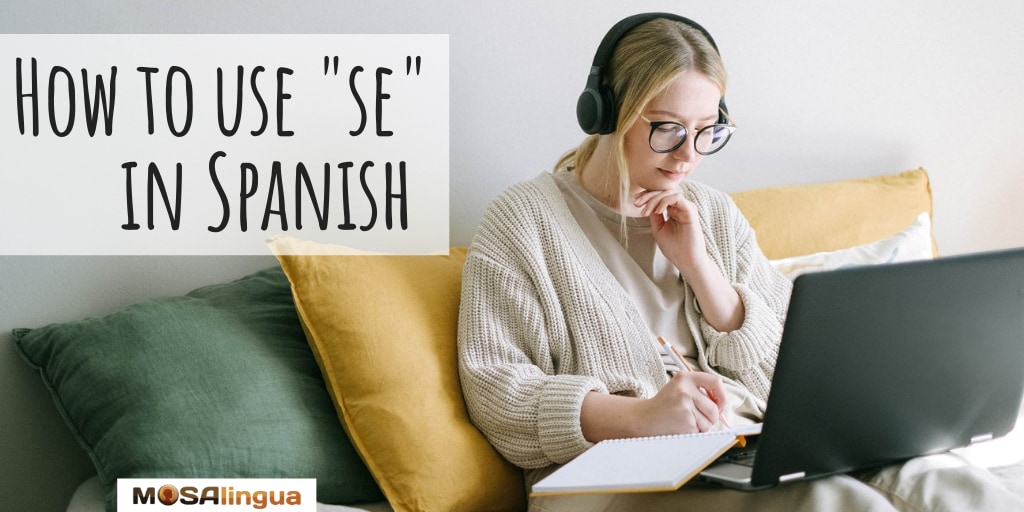Trying to learn Spanish and having trouble with se? When it’s not referring to the verb saber, it’s used as a pronoun. Keep reading for a quick and easy breakdown of the main uses of the pronoun se in Spanish.

8 Ways to Use the Pronoun se in Spanish
One of the most common stumbling blocks for those learning Spanish is the use of the word se. This is all the more frustrating as it’s a common Spanish word that comes up in day-to-day life. That said, there are many different ways se can be used. In this article, we’ll take a look at all the different uses of se and how you can use it like a native Spanish speaker. Check out our list of Spanish language resources for more Spanish grammar tools and other practice materials.
“SÉ” vs “SE”
First, be careful not to mix up sé and se. This is one of the most important distinctions to make. In the first instance, there’s an accent on the e, while the second has none. The accent lets us know that sé refers to the first-person singular of the verb saber, and not the pronoun se. For example:
• Yo sé nadar (I know how to swim)
• Yo sé hablar varios idiomas (I know how to speak a variety of languages)
Se as a personal pronoun
You can also use se as a personal pronoun. In a sentence like “Le dije un secreto a María” (I tell Maria a secret), we can replace the direct object “un secreto” and the indirect object “(a) María” with pronouns to avoid repeating information from a previous sentence. For example, you can say, “Yo le dije un secreto” (I tell her a secret). Here, the pronoun le replaces “a María.” On the other hand, if we want to replace the word beso (kiss), instead of saying “Yo le lo dije” (with the pronoun lo—it, masculin), we must say: “Yo se lo doy” (I tell her it). In this sentence, the pronoun lo replaces secreto and the pronoun se replaces a María.
In summary: use the pronoun se instead of le when there are two pronouns in the same sentence.
Let’s look at some examples:
• El profesor explica gramática a los alumnos (The professor explains grammar to the students) → El profesor se la explica (The professor explains it to them OR The professor explains them it).
• Pablo da un premio a su perro (Pablo gives a treat to his dog) → Pablo se lo da (= Pablo gives him it OR Pablo gives it to him)
Se as a reflexive pronoun
“Reflexive” means that the object of an action is the same as the subject. That is, somebody doing something to themselves. For example, (A) “Yo me ducho” and (B) “Yo me miro en el espejo,” which mean (A) (lit.) “I shower myself” or “I’m taking a shower” and (B) “I look at myself in the mirror.” However, when speaking out himself, herself or themself, we use the pronoun se. For example: “él se ducha” (he showers [himself]) and “ella se mira en el espejo” (she looks at herself in the mirror). It’s also used if there’s a direct object.
Let’s take a look:
• Lucía se lava los dientes (Lucia brushes her teeth)
• Ramón se corta las uñas (Ramón cuts his nails)
Reflexive pronouns and reflexive verbs, in general, are more common in Romance languages like Spanish and French than in English. You’ve probably noticed while studying Spanish that many everyday verbs in English appear as reflexive verbs in Spanish, as in the examples below. In the context of a reflexive verb for himself or herself, always use se in Spanish.
Se as a reciprocal pronoun
This pronoun is used when there are two or more subjects (e.g., he and she, or they) performing the same action on or to each other. For example:
• María y Daniel se miran (Maria and Daniel look at each other). i.e. Maria looks at Daniel and Daniel looks at Maria.
• Mis padres se quieren mucho (My parents love each other a lot). i.e. One of my parents loves the other a lot, and he or she loves them back.
The presence of a direct object in the sentence doesn’t change this. For example: “María y Daniel se escriben cartas” (Maria and Daniel write each other letters). There’s a direct object in the sentence (letters), and we still use se for “each other.”
Passive voice using se in Spanish
In Spanish, using passive voice isn’t very common, contrary to other languages, English included. However, there is another sentence structure in Spanish that’s very common and replaces passive voice, and it uses se. In this case, the action (to be) isn’t performed by the subject. Instead, the “subject” is actually the direct object of a verb used with the third person singular.
For example: “Se venden apartamentos en mi cuidad” (Apartments are for sale in my city).
However, notice that the verb changes according to whether the “direct object” is singular or plural. So if just one apartment is for sale, we say: “Se vende un apartamento en mi cuidad” (An apartment is for sale in my city).
Using “one” as a subject
The use of “one” as a subject in English is becoming less and less common, but it still exists. One can still use “one” (see what we did there?). It’s used when speaking generally, but it’s also used where the subject is unknown, like “somebody” in English. In English, we also use passive voice to this effect (e.g., “One sells an apartment downtown” –> “An apartment is being sold downtown.”)
In either case, you use the pronoun se in Spanish to the same effect.
Let’s have a look:
• En España se come muy bien (One eats very well in Spain)
• En esta escuela se habla con respeto (In this school, one speaks with respect)
To accentuate an action
Only advanced learners need concern themselves with this section, but eventually you’ll want to learn it. It’s useful for accentuating or insisting upon an action performed by a third person (he or she). Take, for example, the following sentence: “Bebió tres copas de vino” (he drank three glasses of wine). The sentence is correct, but if we word it this way: “Se bebió tres copas de vino“, it highlights the fact that he drank a lot. Here’s another example:
• Sara viene siempre a mi casa (Sara always comes over [to my house]) -> Sara se viene siempre a mi casa (we might translate this as: Sara is always coming over [to my house])
As part of a verb
Finally, the pronoun se appears sometimes as an intrinsic part of a verb. That is, some verbs don’t exist without se. It has no particular function, it’s just part of the verb. The se changes with the subject. Take a look:
• Álvaro se queja del tráfico en Madrid (Alvaro complains about the traffic in Madrid), but: Yo me quejo del tráfico en Madrid (I complain about…). The verb is quejarse (to complain). There is no verb quejar.
• Celia se siente sola (Celia feels alone). The verb is sentirse (to feel). If the subject were “you,” we would say: tú te sientes sola (you feel alone).
So there you have the key uses of se in Spanish. As you can see, there are a few rules, but none of them are very complicated. With a good amount of practice, you’ll have all of them down in no time. The next time you see or hear somebody use the word se, think about which of the 8 uses it corresponds to. Listening to Spanish podcasts or doing an online language exchange are two great ways to keep improving.
Learn About se in Spanish: Mirari’s Video
You can find all these tips in the following video with our Spanish teacher Mirari. She recorded it in Spanish, so it’s a great listening comprehension exercise. But you can also turn on English subtitles by clicking on the ⚙️ settings icon in the bottom-right of the video. Use that button to slow down the playback speed if you need to, as well.
Subscribe to our YouTube channel for more tips and lessons
Mastered se in Spanish? Here Are Some Other Spanish Articles You Might Like
If you liked this article about this tricky bit of Spanish grammar, you might also enjoy:
- Hello in Spanish and Other Greetings and Goodbyes
- The MosaLingua Spanish Pronunciation guide (and free PDF)
- Essential Spanish Phrases for Beginners and How to Use Them
Related posts:
Start improving your Spanish today

Good news: we can help!
More good news: you can get started for free! With your free trial, you can test drive the most effective method for learning Spanish for the next 15 days!
Vocabulary flashcards, videos with subtitles, audiobooks, articles adapted to your level – with MosaLingua Premium (Web & Mobile), you’ll have access to all this and more. Get started right now. It’s free—and risk-free—to try!


![Learning Two Languages at the Same Time [VIDEO]](https://www.mosalingua.com/en/files/2017/10/4-300x169.jpg)

Comments